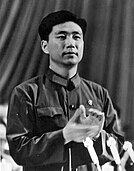
Back Bende van Vier Afrikaans عصابة الأربعة Arabic Banda de los Cuatro AST Банда на четиримата Bulgarian Bandenn ar Pevar Breton Banda dels Quatre Catalan Gang čtyř Czech Firebanden Danish Viererbande German Bando de la Kvar Esperanto
| History of the People's Republic of China |
|---|
 |
|
|
The Gang of Four (simplified Chinese: 四人帮; traditional Chinese: 四人幫; pinyin: Sì rén bāng) was a Maoist political faction composed of four Chinese Communist Party (CCP) officials. They came to prominence during the Cultural Revolution (1966–1976) and were later charged with a series of treasonous crimes due to their responsibility for the excesses and failures in the Cultural Revolution. The gang's leading figure was Jiang Qing (Mao Zedong's last wife). The other members were Zhang Chunqiao, Yao Wenyuan, and Wang Hongwen.[1]
The Gang of Four controlled the power organs of the CCP through the later stages of the Cultural Revolution, although it remains unclear which major decisions were made by Mao Zedong and carried out by the Gang, and which were the result of the Gang of Four's own planning.
Their fall did not amount to a rejection of the Cultural Revolution as such, but it was organized by the new leader, Premier Hua Guofeng, and others who had risen during that period. Significant repudiation of the entire process of change came later, with the return of Deng Xiaoping at the 11th National Congress of the Chinese Communist Party[2] and Hua's gradual loss of authority.[3]
- ^ "Yao Wenyuan". The Economist. ISSN 0013-0613. Archived from the original on 2016-06-23. Retrieved 2016-05-22.
- ^ "1977: Deng Xiaoping back in power". 22 July 1977. Archived from the original on 28 July 2017. Retrieved 18 January 2018 – via news.bbc.co.uk.
- ^ "Hua Guofeng, Transitional Leader of China After Mao, Is Dead at 87". The New York Times. 21 August 2008. Archived from the original on 5 January 2018. Retrieved 18 January 2018.



